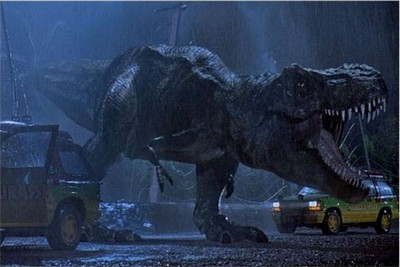Digital Witness
Revolutions in Design, Photography, and Film
LACMA - Los Angeles County Museum of Art
November 24, 2024 - July 13, 2025
With the Exception of Blue, 2013,
Los Angeles County Museum of Art,
purchased with funds provided by LENS: Photography Council
© Melanie Willhide, digital image courtesy of the artist
and Von Lintel Gallery, Los Angeles
Pacific Wave, 1987
Los Angeles County Museum of Art,
Decorative Arts and Design Council Acquisition Fund
and Ralph M. Parsons Fund
© April Greiman, digital image © Museum Associates/LACMA
Dennis Muren (visual effects superviser),
Industrial Light & Magic (production studio),
Universal Pictures (studio),
Still from Jurassic Park, 1993
© 1993 Universal City Studios, Inc.
and Amblin Entertainment, Inc.,
courtesy of Universal Studios Licensing LLC
The Los Angeles County Museum of Art (LACMA) presents Digital Witness: Revolutions in Design, Photography, and Film, which examines the impact of digital image manipulation tools from the 1980s to the present through the works of nearly 200 artists, designers, and makers. Assessing, for the first time, simultaneous developments and debates in the fields of photography, graphic design, and visual effects, the exhibition illuminates today's visual culture where digital editing tools are more accessible than ever before.
Over the last four decades, image-editing software has radically transformed our visual world. This relatively compressed period has taken us from the rise of early paint programs, to the development of both commercially packaged softwares and open-source alternatives, and now the ascension of Al image generators. The increasing ease with which images and text can be digitally generated and altered has enabled new forms of creative experimentation, while also introducing aesthetic and ethical issues across mass media, politics, and advertising. Digital Witness traces these developments with more than 150 photographs, posters, publications, videos, moving image files, film clips, and interactive software experiences. The exhibition charts the emergence of distinctive digital aesthetic strategies, examining how they have altered the patterns, flow, and stakes of visual communication.
Digital Witness: Exhibition Highlights
Organized in three thematic sections, Digital Witness raises questions such as: Where have artists advanced, exploited, or disrupted available means of digital creation and transmission? In what ways can software lead artists, and in what ways can artists shape software? As we are now several decades into the software revolution, can the historical context of "the digital" help us understand its future manifestations?
The exhibition's first section, Blur and Sharpen: Digital Realism, traces artists' efforts to emulate the three-dimensional world and hide evidence of digital interventions. Groundbreaking films from Jurassic Park (1993) to The Lord of the Rings: The Two Towers (2002) and beyond integrated computer graphics with live action and motion capture, embedding fantastical scenarios within otherwise familiar settings or building internally coherent worlds in 3D digital space. Meanwhile, amid initial resistance from traditional darkroom practitioners, photographers including Andreas Gursky and Loretta Lux explored the realm between fact and fiction, seamlessly refining or distorting reality in ways that tested viewers' perceptions and comfort.
Morph and Warp: Computer Aesthetics looks at creators who embraced the rough textures of technology, from April Greiman and John Maeda to Petra Cortwright and Todd Gray. Their work aestheticized glitches such as jagged edges and jerky movements, positing the digital world as its own entity rathert han an imitation of analog life. In some cases, this took a surrealistic form, with distorted shapes and colors that foregrounded technological possibilities and explored the extremes allowed by the new medium. In particular, motion graphics such as title sequences, kinetic typography, music videos, and advertisements were sites of experimentation.
The final section, Cut and Paste: Digital Collage, highlights artists like Keith Piper, Lucas Blalock, and Casey Kauffmann, who found creative potential in editing advances, taking analog art forms—collage in particular, with its potential for surreal juxtapositions—to digitally enabled extremes. In contrast, examples throughout the exhibition demonstrate how artists have resisted dominant commercial softwares, developing open-source alternatives such as Urs and Jürg Lehni's Scriptographer plug-in.
Publication: The exhibition is accompanied by a substantial, image-packed catalogue, co-published by LACMA and DelMonico Books/D.A.P., featuring Q&As with noted visual artists, filmmakers, and designers David Fincher, Copper Frances Giloth, April Greiman, MANUAL, LaJune McMillian, Rosa Menkman, Sert Monroy, Casey Reas, Thomas Ruff, Kyuha Shim, Raqi Syed, and Cesar Velazquez. The publication is edited with an introduction by Britt Salvesen and Staci Steinberger, and includes scholarly essays by Kim Beil, Hye Jean Chung, Carolyn L. Kane, Briar Levit, Staci Steinberger, and Anuradha Vikram. It was created as part of the PST ART: Art & Science Collide series.
This exhibition was organized by the Los Angeles County Museum of Art.
Digital Witness is presented as part of PST ART: Art & Science Collide, a landmark regional event exploring the intersections of art and science, both past and present. The exhibition is co-curated by Britt Salvesen, Department Head and Curator of the Wallis Annenberg Photography Department and Prints and Drawings, and Staci Steinberger, Curator of Decorative Arts and Design, at LACMA.
LACMA - Los Angeles County Museum of Art
5905 Wilshire Boulevard, Los Angeles, CA, 90036
BCAM, Levels 1 & 2



